动画的12条基本原理
- 格式:doc
- 大小:65.50 KB
- 文档页数:9
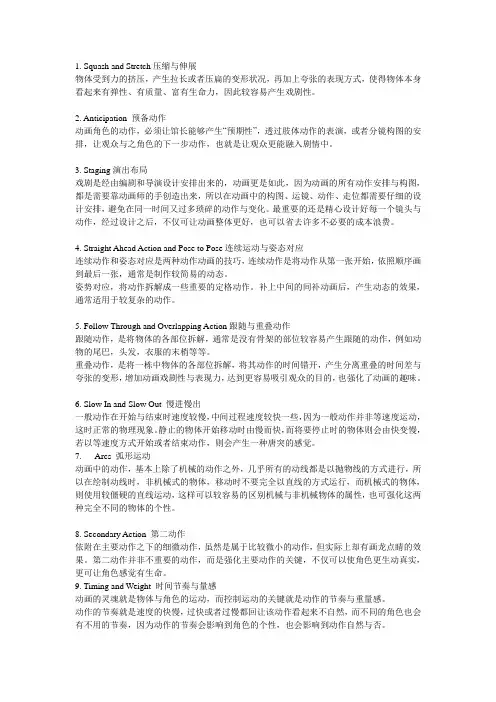
1. Squash and Stretch压缩与伸展物体受到力的挤压,产生拉长或者压扁的变形状况,再加上夸张的表现方式,使得物体本身看起来有弹性、有质量、富有生命力,因此较容易产生戏剧性。
2. Anticipation 预备动作动画角色的动作,必须让馆长能够产生“预期性”,透过肢体动作的表演,或者分镜构图的安排,让观众与之角色的下一步动作,也就是让观众更能融入剧情中。
3. Staging演出布局戏剧是经由编剧和导演设计安排出来的,动画更是如此,因为动画的所有动作安排与构图,都是需要靠动画师的手创造出来,所以在动画中的构图、运镜、动作、走位都需要仔细的设计安排,避免在同一时间又过多琐碎的动作与变化。
最重要的还是精心设计好每一个镜头与动作,经过设计之后,不仅可让动画整体更好,也可以省去许多不必要的成本浪费。
4. Straight Ahead Action and Pose to Pose连续运动与姿态对应连续动作和姿态对应是两种动作动画的技巧,连续动作是将动作从第一张开始,依照顺序画到最后一张,通常是制作较简易的动态。
姿势对应,将动作拆解成一些重要的定格动作。
补上中间的间补动画后,产生动态的效果,通常适用于较复杂的动作。
5. Follow Through and Overlapping Action跟随与重叠动作跟随动作,是将物体的各部位拆解,通常是没有骨架的部位较容易产生跟随的动作,例如动物的尾巴,头发,衣服的末梢等等。
重叠动作,是将一栋中物体的各部位拆解,将其动作的时间错开,产生分离重叠的时间差与夸张的变形,增加动画戏剧性与表现力,达到更容易吸引观众的目的,也强化了动画的趣味。
6. Slow In and Slow Out 慢进慢出一般动作在开始与结束时速度较慢,中间过程速度较快一些,因为一般动作并非等速度运动,这时正常的物理现象。
静止的物体开始移动时由慢而快,而将要停止时的物体则会由快变慢,若以等速度方式开始或者结束动作,则会产生一种唐突的感觉。

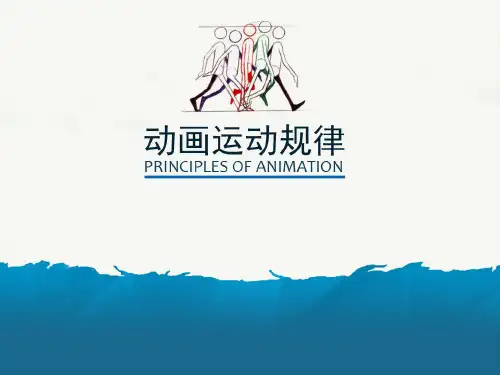
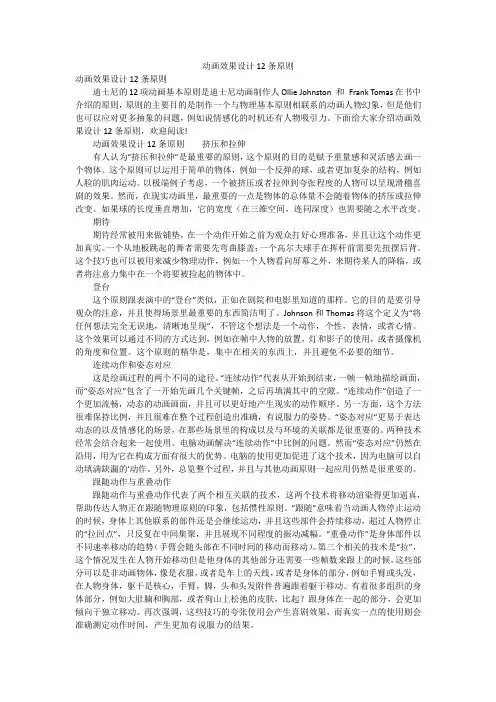
动画效果设计12条原则动画效果设计12条原则迪士尼的12项动画基本原则是迪士尼动画制作人Ollie Johnston 和Frank Tomas在书中介绍的原则,原则的主要目的是制作一个与物理基本原则相联系的动画人物幻象,但是他们也可以应对更多抽象的问题,例如说情感化的时机还有人物吸引力。
下面给大家介绍动画效果设计12条原则,欢迎阅读!动画效果设计12条原则挤压和拉伸有人认为“挤压和拉伸”是最重要的原则,这个原则的目的是赋予重量感和灵活感去画一个物体。
这个原则可以运用于简单的物体,例如一个反弹的球,或者更加复杂的结构,例如人脸的肌肉运动。
以极端例子考虑,一个被挤压或者拉伸到夸张程度的人物可以呈现滑稽喜剧的效果。
然而,在现实动画里,最重要的一点是物体的总体量不会随着物体的挤压或拉伸改变。
如果球的长度垂直增加,它的宽度(在三维空间,连同深度)也需要随之水平改变。
期待期待经常被用来做铺垫,在一个动作开始之前为观众打好心理准备,并且让这个动作更加真实。
一个从地板跳起的舞者需要先弯曲膝盖;一个高尔夫球手在挥杆前需要先扭摆后背。
这个技巧也可以被用来减少物理动作,例如一个人物看向屏幕之外,来期待某人的降临,或者将注意力集中在一个将要被捡起的物体中。
登台这个原则跟表演中的“登台”类似,正如在剧院和电影里知道的那样。
它的目的是要引导观众的注意,并且使得场景里最重要的东西简洁明了。
Johnson和Thomas将这个定义为“将任何想法完全无误地,清晰地呈现”,不管这个想法是一个动作,个性,表情,或者心情。
这个效果可以通过不同的方式达到,例如在帧中人物的放置,灯和影子的使用,或者摄像机的角度和位置。
这个原则的精华是,集中在相关的东西上,并且避免不必要的细节。
连续动作和姿态对应这是绘画过程的两个不同的途径。
“连续动作”代表从开始到结束,一帧一帧地描绘画面,而“姿态对应”包含了一开始先画几个关键帧,之后再填满其中的空隙。
“连续动作”创造了一个更加流畅,动态的动画画面,并且可以更好地产生现实的动作顺序。
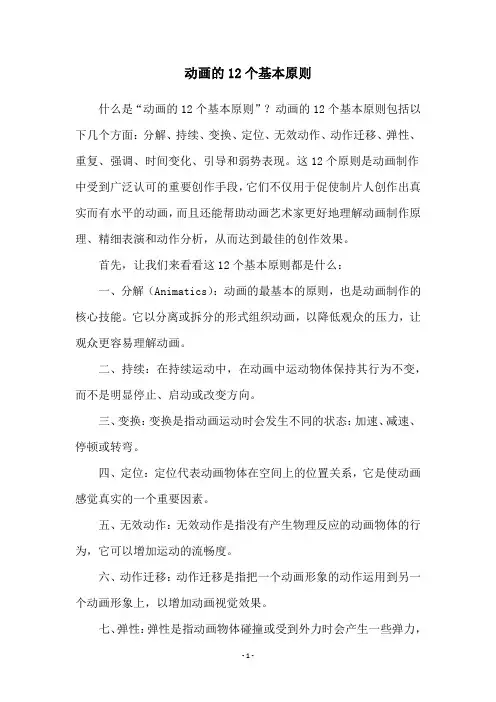
动画的12个基本原则什么是“动画的12个基本原则”?动画的12个基本原则包括以下几个方面:分解、持续、变换、定位、无效动作、动作迁移、弹性、重复、强调、时间变化、引导和弱势表现。
这12个原则是动画制作中受到广泛认可的重要创作手段,它们不仅用于促使制片人创作出真实而有水平的动画,而且还能帮助动画艺术家更好地理解动画制作原理、精细表演和动作分析,从而达到最佳的创作效果。
首先,让我们来看看这12个基本原则都是什么:一、分解(Animatics):动画的最基本的原则,也是动画制作的核心技能。
它以分离或拆分的形式组织动画,以降低观众的压力,让观众更容易理解动画。
二、持续:在持续运动中,在动画中运动物体保持其行为不变,而不是明显停止、启动或改变方向。
三、变换:变换是指动画运动时会发生不同的状态:加速、减速、停顿或转弯。
四、定位:定位代表动画物体在空间上的位置关系,它是使动画感觉真实的一个重要因素。
五、无效动作:无效动作是指没有产生物理反应的动画物体的行为,它可以增加运动的流畅度。
六、动作迁移:动作迁移是指把一个动画形象的动作运用到另一个动画形象上,以增加动画视觉效果。
七、弹性:弹性是指动画物体碰撞或受到外力时会产生一些弹力,这样可以增强动画形象的真实感和动感。
八、重复:重复是指在动画中重复使用某一段动作,以呈现特定的动作效果,也可以增加动画的可视性。
九、强调:强调是指通过修改动画物体的位置、大小或速度等参数,来提高视觉效果,使动作更加明显。
十、时间变化:时间变化是指动画运动的时间变化,通过改变动画的实际运行时间来增加其动作的动态性。
十一、引导:引导是指在动画序列中对动画客体的行为和动作给予引导,以使动画客体的动作变得更加自然、有条不紊。
十二、弱势表现:在动画中,柔和的表演出动画物体在休息或放松时的状态及其心理实质,有助于更好地把握动画形象的内在特质。
以上是动画的12个基本原则的概述。
这些基本原则对动画艺术家来说十分重要,它们能够帮助更好地理解动画,从而更好地创作出真实、有水准的动画作品。
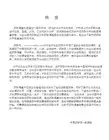
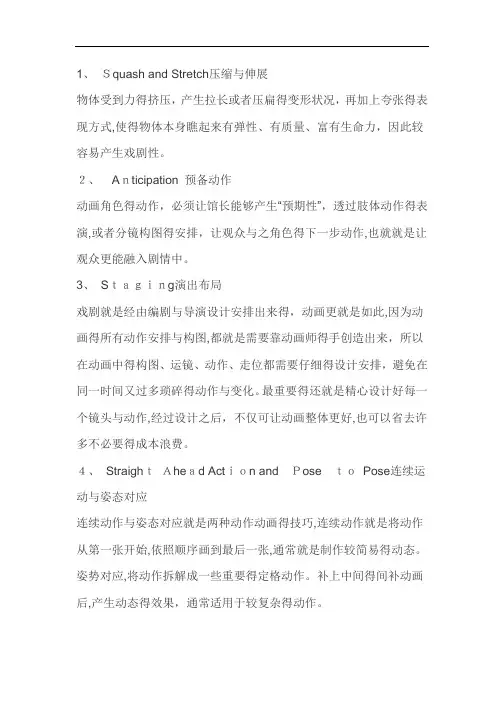
1、Squash and Stretch压缩与伸展物体受到力得挤压,产生拉长或者压扁得变形状况,再加上夸张得表现方式,使得物体本身瞧起来有弹性、有质量、富有生命力,因此较容易产生戏剧性。
2、Anticipation 预备动作动画角色得动作,必须让馆长能够产生“预期性”,透过肢体动作得表演,或者分镜构图得安排,让观众与之角色得下一步动作,也就就是让观众更能融入剧情中。
3、Staging演出布局戏剧就是经由编剧与导演设计安排出来得,动画更就是如此,因为动画得所有动作安排与构图,都就是需要靠动画师得手创造出来,所以在动画中得构图、运镜、动作、走位都需要仔细得设计安排,避免在同一时间又过多琐碎得动作与变化。
最重要得还就是精心设计好每一个镜头与动作,经过设计之后,不仅可让动画整体更好,也可以省去许多不必要得成本浪费。
4、StraightAhead Action andPosetoPose连续运动与姿态对应连续动作与姿态对应就是两种动作动画得技巧,连续动作就是将动作从第一张开始,依照顺序画到最后一张,通常就是制作较简易得动态。
姿势对应,将动作拆解成一些重要得定格动作。
补上中间得间补动画后,产生动态得效果,通常适用于较复杂得动作。
5、FollowThrough andOverlappingAction跟随与重叠动作跟随动作,就是将物体得各部位拆解,通常就是没有骨架得部位较容易产生跟随得动作,例如动物得尾巴,头发,衣服得末梢等等.重叠动作,就是将一栋中物体得各部位拆解,将其动作得时间错开,产生分离重叠得时间差与夸张得变形,增加动画戏剧性与表现力,达到更容易吸引观众得目得,也强化了动画得趣味。
6、Slow In and Slow Out慢进慢出一般动作在开始与结束时速度较慢,中间过程速度较快一些,因为一般动作并非等速度运动,这时正常得物理现象。
静止得物体开始移动时由慢而快,而将要停止时得物体则会由快变慢,若以等速度方式开始或者结束动作,则会产生一种唐突得感觉。
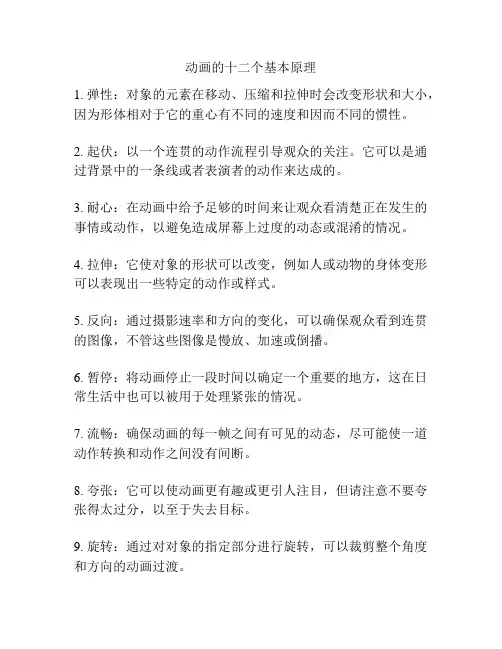
动画的十二个基本原理
1. 弹性:对象的元素在移动、压缩和拉伸时会改变形状和大小,因为形体相对于它的重心有不同的速度和因而不同的惯性。
2. 起伏:以一个连贯的动作流程引导观众的关注。
它可以是通过背景中的一条线或者表演者的动作来达成的。
3. 耐心:在动画中给予足够的时间来让观众看清楚正在发生的事情或动作,以避免造成屏幕上过度的动态或混淆的情况。
4. 拉伸:它使对象的形状可以改变,例如人或动物的身体变形可以表现出一些特定的动作或样式。
5. 反向:通过摄影速率和方向的变化,可以确保观众看到连贯的图像,不管这些图像是慢放、加速或倒播。
6. 暂停:将动画停止一段时间以确定一个重要的地方,这在日常生活中也可以被用于处理紧张的情况。
7. 流畅:确保动画的每一帧之间有可见的动态,尽可能使一道动作转换和动作之间没有间断。
8. 夸张:它可以使动画更有趣或更引人注目,但请注意不要夸张得太过分,以至于失去目标。
9. 旋转:通过对对象的指定部分进行旋转,可以裁剪整个角度和方向的动画过渡。
10. 加速:通过摄影速度的变化,在某些情况下,加速可以帮
助观众更好地理解动画图像。
11. 区分:区分可以用于展示或隐藏特定对象,也可以用于强
调某些元素,以在观众的眼中产生明显的区别。
12. 循环:在动画循环中添加起伏或起伏可以增加视觉吸引力。
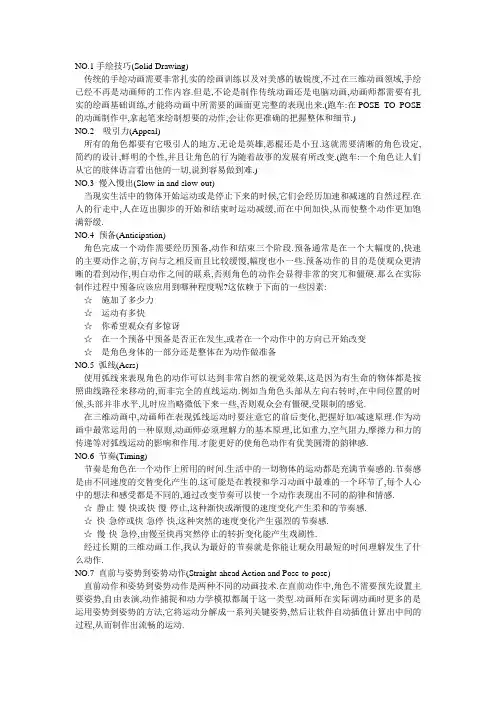
NO.1手绘技巧(Solid Drawing)传统的手绘动画需要非常扎实的绘画训练以及对美感的敏锐度,不过在三维动画领域,手绘已经不再是动画师的工作内容.但是,不论是制作传统动画还是电脑动画,动画师都需要有扎实的绘画基础训练,才能将动画中所需要的画面更完整的表现出来.(跑车:在POSE TO POSE 的动画制作中,拿起笔来绘制想要的动作,会让你更准确的把握整体和细节.)NO.2 吸引力(Appeal)所有的角色都要有它吸引人的地方,无论是英雄,恶棍还是小丑.这就需要清晰的角色设定,简约的设计,鲜明的个性,并且让角色的行为随着故事的发展有所改变.(跑车:一个角色让人们从它的肢体语言看出他的一切,说到容易做到难.)NO.3 慢入慢出(Slow-in and slow-out)当现实生活中的物体开始运动或是停止下来的时候,它们会经历加速和减速的自然过程.在人的行走中,人在迈出脚步的开始和结束时运动减缓,而在中间加快,从而使整个动作更加饱满舒缓.NO.4 预备(Anticipation)角色完成一个动作需要经历预备,动作和结束三个阶段.预备通常是在一个大幅度的,快速的主要动作之前,方向与之相反而且比较缓慢,幅度也小一些.预备动作的目的是使观众更清晰的看到动作,明白动作之间的联系,否则角色的动作会显得非常的突兀和僵硬.那么在实际制作过程中预备应该应用到哪种程度呢?这依赖于下面的一些因素:☆施加了多少力☆运动有多快☆你希望观众有多惊讶☆在一个预备中预备是否正在发生,或者在一个动作中的方向已开始改变☆是角色身体的一部分还是整体在为动作做准备NO.5 弧线(Acrs)使用弧线来表现角色的动作可以达到非常自然的视觉效果,这是因为有生命的物体都是按照曲线路径来移动的,而非完全的直线运动.例如当角色头部从左向右转时,在中间位置的时候,头部并非水平,儿时应当略微低下来一些,否则观众会有僵硬,受限制的感觉.在三维动画中,动画师在表现弧线运动时要注意它的前后变化,把握好加/减速原理.作为动画中最常运用的一种原则,动画师必须理解力的基本原理,比如重力,空气阻力,摩擦力和力的传递等对弧线运动的影响和作用.才能更好的使角色动作有优美圆滑的韵律感.NO.6 节奏(Timing)节奏是角色在一个动作上所用的时间.生活中的一切物体的运动都是充满节奏感的.节奏感是由不同速度的交替变化产生的.这可能是在教授和学习动画中最难的一个环节了,每个人心中的想法和感受都是不同的,通过改变节奏可以使一个动作表现出不同的韵律和情感.☆静止-慢-快或快-慢-停止,这种渐快或渐慢的速度变化产生柔和的节奏感.☆快-急停或快-急停-快,这种突然的速度变化产生强烈的节奏感.☆慢-快-急停,由慢至快再突然停止的转折变化能产生戏剧性.经过长期的三维动画工作,我认为最好的节奏就是你能让观众用最短的时间理解发生了什么动作.NO.7 直前与姿势到姿势动作(Straight-ahead Action and Pose-to-pose)直前动作和姿势到姿势动作是两种不同的动画技术.在直前动作中,角色不需要预先设置主要姿势,自由表演,动作捕捉和动力学模拟都属于这一类型.动画师在实际调动画时更多的是运用姿势到姿势的方法,它将运动分解成一系列关键姿势,然后让软件自动插值计算出中间的过程,从而制作出流畅的运动.在长期的的动画制作中,我感觉姿势到姿势的动画方式简便干净,但总体来说过于卡通化和模式化,并且通常会连带出一些多余的跟随动作,不适合写实风格的动画片.不过对于有经验的动画师来说,选择何种方式都能最终达到想要的效果.NO.8 挤压和拉伸(Squash and Stretch)挤压和拉伸是动画原则中的第一条金科玉律.我们在动画中为了得到一个相对稳定且又富有弹性的鲜活角色,就必须运用这条原则,对于卡通角色更是如此.它可以生动地体现角色的构成,尺寸和重量,展示力的大小(力越大,挤压和拉伸的效果越强,反之亦然),以及获得更自然的面部表情动画.在三维动画中,这种效果不能单纯靠角色表面的变化来表现,因为角色的身体是以后体积的,由内在的骨架来支撑,所以动画师在制作挤压和拉伸效果时要基于移动骨架产生形变,同事又要通过其他辅助手段来保持角色的体积是恒定的.只有这样做出来的效果才真实可信,而不会使角色看上去像一滩烂泥.NO.9 夸张(Exaggeration)夸张通常将角色的局部或者大部分强化到极致,用来表现角色的力量和精神状态,以及给观众留下深刻的印象.三维动画中夸张主要有两种表现形式:☆形态的夸张:依靠强烈的形变,超过极限的动作,给观众以强烈的印象.☆效果的夸张:快的更快,慢的更慢.硬的更硬,软的更软.想要达到好的夸张效果,需要动画师有高度的概括能力,使角色最快的表现自身的性格特点和动作风格.除了形态上的夸张之外,速度的快慢强烈对比也能达到效果上的夸张,而且这种方法能通过镜头的切换移动和后期剪辑来实现.制作时,动画师应该首先理解角色动作的目的和剧情的需要,然后再决定在哪个时间段需要夸张的处理.只有适当的,巧妙的夸张才能为动画增添可信有趣的视觉效果.NO.10 初步动画阶段(Staging)初步动画阶段,也就是我们熟悉的Layout,通过设置角色的几个最主要的关键帧把整个场景中大致的动画基调和意图表现出来.Previs(三维预览)是做到这一点的最好方式,它可以通过专业的图形软件,得到实时,细致的材质,灯光和特效.(这里推荐Motionbuilder)NO.11 次要动作(Sceondary Action)次要动作是由一系列小的运动组成的,它用来丰富主要动作的细节,增加动画的趣味性和真实性.添加次要动作要适当,既要使次要动作能让观众所察觉,又不能掩盖过角色的主要动作.例如当一个角色坐在桌子上思考,观众视线的焦点会集中在角色表情的变化上,但为了使角色的表演更为自然,动画师通常需要加一些次要动作来丰富这个主要动作,比如手指在桌面上弹几下等一些细微的小动作.制作时,动画师一般是先完成角色的主要动作,再添加次要动作来辅助角色的表演.除了肢体语言,次级在表情演绎中也广泛的应用.例如在哭戏当中,除了要表现演员哭泣的双眼,紧缩的眉头,悲痛欲绝的神情,还可以添加一些嘴唇的缠头,鼻翼的抽搐等次要动作,使得整个表演更能表现角色痛苦的深度,也能更好的感染观众.NO.12 跟随和交迭动作(Follow-through & Overlapping Action)跟随动作是主要动作的一种延伸,就像衣服上的飘带总是试图跟上跑步中的角色一样,所以跟随动作取决于角色的主要动作,空气阻力以及自身重量和质地等因素.交迭运动是力通过一个可以旋转的关节向下逐层传递,当前一个关节的旋转还在进行时下一个关节的旋转已经开始了,在三维动画制作中,应根据剧情发展为角色设计一些跟随和交迭动作.尽管这样会有些复杂,但是可以让角色的动作更具有趣味性.比如角色有长尾巴,长头发和长耳朵时,动画师可以为他们添加跟随和交迭动作,从而是姿势到姿势的方式制作出来的动作摆脱可怕的僵硬感这14条动画制作法则是由Disney的动画师累积数十年的经验所整理出来的最高指导原则,我们可是要把他们当做圣旨一般的信奉,虽然Disney的动画早在30年代已经发光发热,然而当初的动画制作原则延传至今仍然不变,甚至这些由2D动画制作发展出来的规则,也几乎完全能够应用在3D动画制作之上,如果各位对于Disney动画发展史有兴趣,或是非常想深入了解这些动画基本法则的奥秘,可参参考Frank Thomas and Ollie Johnston所著的The Illusion of Life isney Animation.这本书亦为所有动画师争相收藏的圣经宝典了。
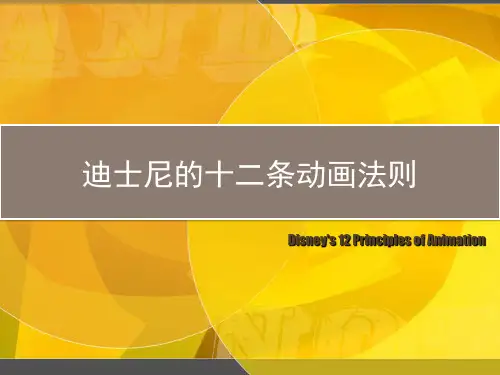
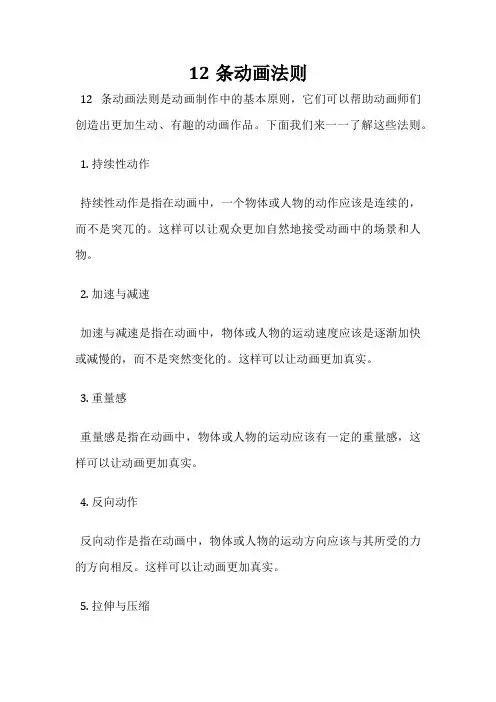
12条动画法则12条动画法则是动画制作中的基本原则,它们可以帮助动画师们创造出更加生动、有趣的动画作品。
下面我们来一一了解这些法则。
1. 持续性动作持续性动作是指在动画中,一个物体或人物的动作应该是连续的,而不是突兀的。
这样可以让观众更加自然地接受动画中的场景和人物。
2. 加速与减速加速与减速是指在动画中,物体或人物的运动速度应该是逐渐加快或减慢的,而不是突然变化的。
这样可以让动画更加真实。
3. 重量感重量感是指在动画中,物体或人物的运动应该有一定的重量感,这样可以让动画更加真实。
4. 反向动作反向动作是指在动画中,物体或人物的运动方向应该与其所受的力的方向相反。
这样可以让动画更加真实。
5. 拉伸与压缩拉伸与压缩是指在动画中,物体或人物在运动过程中会因为速度的变化而发生形变。
这样可以让动画更加生动。
6. 次要动作次要动作是指在动画中,物体或人物的运动过程中会产生一些次要的动作,比如头发、衣服等的晃动。
这样可以让动画更加生动。
7. 引导线引导线是指在动画中,物体或人物的运动轨迹应该是流畅的,而不是突兀的。
这样可以让动画更加自然。
8. 呼吸呼吸是指在动画中,人物的呼吸应该是自然的,这样可以让动画更加真实。
9. 反复反复是指在动画中,某些动作可以反复出现,比如人物的眨眼、摇头等。
这样可以让动画更加生动。
10. 色彩色彩是指在动画中,色彩的运用应该是合理的,可以表现出不同的情感和氛围。
11. 立体感立体感是指在动画中,物体或人物的立体感应该是明显的,这样可以让动画更加真实。
12. 意识流意识流是指在动画中,人物的内心活动应该通过一些特殊的手法来表现出来,比如梦境、幻觉等。
这样可以让动画更加有趣。
12条动画法则是动画制作中的基本原则,它们可以帮助动画师们创造出更加生动、有趣的动画作品。
在动画制作中,我们应该根据不同的情况来灵活运用这些法则,以创造出更加优秀的动画作品。
The 12 Basic Principles of Animation 动画的12条基本原则The 12 basic principles of animation are listed below. You may see them in a slightly different form or order in oth er articles, books or magazines. I have listed them here as shown, because I feel this order facilitates learning them more easily. You can learn one first, then go on to the next building up your skills. I also feel they tend to be relate d, and flow more easily from one to the other in this order.下面列出了动画的12条基本原则,也许在其他的文章或者书刊中有过不同版本,但内容基本类似。
按照这个顺序列出它们,我觉得会更方便大家理解。
你们可以从第一个学起,然后逐个学习,加深理解。
同时,我也感到它们之间又是交叉联系的。
按照这个顺序学习的话,将来运用的会更加自如。
1. Timing2. Ease In and Out (or Slow In and Out)3. Arcs4. Anticipation5. Exaggeration6. Squash and Stretch7. Secondary Action8. Follow Through and Overlapping Action9. Straight Ahead Action and Pose-To-Pose Action10. Staging11. Appeal12. PersonalityBy following and knowing when, where and how to apply these basic ideas, and by understanding them, one shoul d be able to create good animation. It is important to note that simply memorizing these principles isn't the point. N o one will care whether or not you know this list. It's whether or not you truly understand and can utilize these idea s that matter. If you do, it will show automatically in your work.通过学习并理解清楚什么时间,什么地方,和怎样运用这些基本法则后,你应该能够制作出比较优秀的动画出来了。
12条动画法则
以下是12条动画法则:
1. 直线运动:物体在直线上移动时速度是恒定的。
2. 弧线运动:物体在弧线上移动时速度会变化。
3. 加速度:物体在移动时速度会加快或减慢。
4. 减速度:物体在停止时速度会减慢。
5. 重量感:物体的重量感取决于它的大小和形状。
6. 反向动作:物体在停止或改变方向时会产生反向动作。
7. 拉伸:物体在移动时会因为速度的变化而产生拉伸。
8. 按比例缩放:物体在远离或靠近镜头时会按比例缩放。
9. 重叠:物体在移动时会产生重叠效果。
10. 拖尾:物体在移动时会产生拖尾效果。
11. 互动:物体之间的互动会影响它们的运动。
12. 呼吸:物体在静止时会有呼吸效果,即微小的大小变化。
动画的12条黄⾦法则Twelve Basic Principles of Animation (1)The 12 basic principles of animation are a set of principles of animation introduced by the Disney animator Ollie Johnston and Frank Thomas in their book The Illusion of Life: Disney Animation (1981). Johnston and Thomas in turn based their book on the work of the leading Disney animators from the 1930s onwards, and their effort to produce more realistic animations. The main purpose of the principles was to produce an illusion of characters adhering to the basic laws of physics, but they also dealt with more abstract issues, such as emotional timing and character appeal.The book and its principles have became generally adopted, and been referred to as the “Bible of the industry”. In 1999 the book was voted number one of the “best animation book of all time” via an online poll. Though the original intention was to apply them to traditional, hand-drawn animation, the principles still have great relevance for today’s more prevalent computer animation. Squash and stretchThe most important principle is “squash and stretch”, the purpose of which is to give weight and flexibility to drawn objects. It can be applied to simple objects, like a bouncing ball, or more complex constructions, like the musculature of a human face. Taken to an extreme point, a figure stretched or squashed to an exaggerated degree can have a comical effect. In realistic animation, however, the most important aspect of this principle is the fact that an object’s volume does not change when squashed or stretched. If the length of a ball is stretched vertically, its width (in three dimensions, also its depth) needs to contract correspondingly horizontally.AnticipationAnticipation is used to prepare the audience for an action, and to make the action appear more realistic. A dancer jumping off the floor has to bend his knees first; a golfer making a swing has to swing the club back first. The technique can also be used for less physical actions, such as a character looking off-screen to anticipate someone’s arrival, or attention focusing on an object that a character is about to pick up. For special effect, anticipation can also be omitted in cases where it is expected. The resulting scene of anticlimax will produce a feeling of surprise in the viewer, and can often add comedy to a scene. This is often referred to as a “surprising gag”.StagingThis principle is akin to staging as it is known in theatre and film. Its purpose is to direct the audience’s attention, and make it clear what is of greatest importance in a scene; what is happening, and what is about to happen. Johnston and Thomas defined it as “the presentation of any idea so that it is completely and unmistakably clear”, whether that idea is an action, a personality, an expression or a mood. This can be done by various means, such as the placement of a character in a frame, the use of light and shadow, and the angle and position of the camera. The essence of this principle is keeping focus on what is relevant, and avoiding unnecessary detail. Straight ahead action and pose to poseThere are two different approaches to the actual drawings process. “Straight ahead action” means drawing out a scene frame by frame from beginning to end, while “pose to pose” involves starting with drawing a few, key frames, and then filling in the intervals later. “Straight ahead action”creates a more fluid, dynamic illusion of movement, and is better for producing realistic action sequences. On the other hand, it is hard to maintain proportions, and to create exact, convincing poses along the way.“Pose to pose” works better for dramatic or emotional scenes. A combination of the two techniques is often used. Computer animation removes the problems of proportion related to “straight ahead action”drawing; however, “pose to pose”is still used for computer animation, because of the advantages it brings in composition. The use of computers facilitates this method, as computers an fill the missing sequences in between poses automatically. It is, however, still important to oversee this process, and apply the other principles discussed.12 basic principles of animation:动画的12条黄⾦法则The Illusion of Life: Disney Animation:《迪⼠尼-⽣命的景象》Squash and stretch:压缩与伸展Anticipation:预备动作动画预期Staging:演出布局Straight ahead action and pose to pose:连续运动与姿态对应。
1. Squash and Stretch压缩与伸展物体受到力的挤压,产生拉长或者压扁的变形状况,再加上夸张的表现方式,使得物体本身看起来有弹性、有质量、富有生命力,因此较容易产生戏剧性。
2. Anticipation 预备动作动画角色的动作,必须让馆长能够产生“预期性”,透过肢体动作的表演,或者分镜构图的安排,让观众与之角色的下一步动作,也就是让观众更能融入剧情中。
3. Staging演出布局戏剧是经由编剧和导演设计安排出来的,动画更是如此,因为动画的所有动作安排与构图,都是需要靠动画师的手创造出来,所以在动画中的构图、运镜、动作、走位都需要仔细的设计安排,避免在同一时间又过多琐碎的动作与变化。
最重要的还是精心设计好每一个镜头与动作,经过设计之后,不仅可让动画整体更好,也可以省去许多不必要的成本浪费。
4. Straight Ahead Action and Pose to Pose连续运动与姿态对应连续动作和姿态对应是两种动作动画的技巧,连续动作是将动作从第一张开始,依照顺序画到最后一张,通常是制作较简易的动态。
姿势对应,将动作拆解成一些重要的定格动作。
补上中间的间补动画后,产生动态的效果,通常适用于较复杂的动作。
5. Follow Through and Overlapping Action跟随与重叠动作跟随动作,是将物体的各部位拆解,通常是没有骨架的部位较容易产生跟随的动作,例如动物的尾巴,头发,衣服的末梢等等。
重叠动作,是将一栋中物体的各部位拆解,将其动作的时间错开,产生分离重叠的时间差与夸张的变形,增加动画戏剧性与表现力,达到更容易吸引观众的目的,也强化了动画的趣味。
6. Slow In and Slow Out 慢进慢出一般动作在开始与结束时速度较慢,中间过程速度较快一些,因为一般动作并非等速度运动,这时正常的物理现象。
静止的物体开始移动时由慢而快,而将要停止时的物体则会由快变慢,若以等速度方式开始或者结束动作,则会产生一种唐突的感觉。
介绍一下动画的12条基本的法则NO.1手绘伎俩(Solid Drawing)激进的手绘动画需要很是浮躁的绘画训练以及对美感的凶猛度,不外在三维动画范畴,手绘曾经再也不是动画师的工作模式.但是,无论是制作传统动画照样电脑动画,动画师都须要有火暴的绘画根底训练,才能将动画中所紧要的画面更残缺的透露表现进去.(跑车:在POSE TO POSE的动画打造中,拿起笔来绘制想要的行动,会让你更正确的驾驭团体和细节.)NO.2 排汇力(Appeal)所有的脚色都要有它吸收人的中央,无论是英雄,恶棍照常小丑.这就重要清晰的角色设定,简约的筹算,鲜白的特性,而且让脚色的举止随着故事的发展有所窜改.(跑车:一个脚色让人们从它的肢体语言看出他的所有,说到容易做到难.) NO.3 慢入慢出(Slow-in and slow-out)当现实保管中的物体入手下手运动或是终了下来的时刻,它们会履历加速和减速的人造过程.在人的行走中,人在迈出脚步的劈头与结束时运动缓解,而在两端加快,从而使整个行动更为蕉萃舒缓.NO.4 预备(Anticipation)角色完成一个行动必要履历预备,动作与竣事三个阶段.预备一般为在一个大幅度的,神速的首要行动以前,偏袒与之雷同而且相比机灵,幅度也小一些.预备动作的方针是使观众更清楚的看到动作,熟谙行动之间的肢解,否则脚色的动作会显得尤其的特立和僵硬.那末在理论产进程中预备应该运用到哪一种水准呢?这奉求于上面的一些成分:☆施加了若干力☆流动有多快☆你盼望观众有多吃惊☆在一个预备中预备能否正在发生发火,或者在一个动作中的偏袒已起头旋转☆是角色身体的一部分还是个人在为动作做操办NO.5 弧线(Acrs)使用弧线来浮现脚色的行动可以抵达尤为自然的视觉成绩,这是因为有生命的物体都是根据曲线路子来挪动的,而非完全的直线流动.例如当角色头部从左向右转时,在中间身分的时刻,头部并不是水平,儿时应该稍微低上去一些,不然观众会有生硬,受限定的感受.在三维动画中,动画师在闪现弧线流动时要寄望它的先后变动,驾驭好加/减速事理.作为动画中最常运用的一种原则,动画师必需理解力的基来源根基理,比喻重力,空气阻力,争吵力与力的传递等对弧线运动的影响和作用.才能更好的使角色行动有优美圆滑的韵律感.NO.6 节奏(Timing)节奏是角色在一个动作上所用的时间.生活中的一切物体的运动都是充满节奏感的.节奏感是由不同速度的交替变化产生的.这可能是在教授和学习动画中最难的一个环节了,每个人心中的想法和感受都是不同的,通过改变节奏可以使一个动作表现出不同的韵律和情感.☆静止-慢-快或快-慢-停止,这种渐快或渐慢的速度变化产生柔和的节奏感. ☆快-急停或快-急停-快,这种突然的速度变化产生强烈的节奏感.☆慢-快-急停,由慢至快再突然停止的转折变化能产生戏剧性.经过长期的三维动画工作,我认为最好的节奏就是你能让观众用最短的时间理解发生了什么动作.NO.7 直前与姿势到姿势动作(Straight-ahead Action and Pose-to-pose)直前动作和姿势到姿势动作是两种不同的动画技术.在直前动作中,角色不需要预先设置主要姿势,自由表演,动作捕捉和动力学模拟都属于这一类型.动画师在实际调动画时更多的是运用姿势到姿势的方法,它将运动分解成一系列关键姿势,然后让软件自动插值计算出中间的过程,从而制作出流畅的运动.在长期的的动画制作中,我感觉姿势到姿势的动画方式简便干净,但总体来说过于卡通化和模式化,并且通常会连带出一些多余的跟随动作,不适合写实风格的动画片.不过对于有经验的动画师来说,选择何种方式都能最终达到想要的效果.NO.8 挤压和拉伸(Squash and Stretch)挤压和拉伸是动画原则中的第一条金科玉律.我们在动画中为了得到一个相对稳定且又富有弹性的鲜活角色,就必须运用这条原则,对于卡通角色更是如此.它可以生动地体现角色的构成,尺寸和重量,展示力的大小(力越大,挤压和拉伸的效果越强,反之亦然),以及获得更自然的面部表情动画.在三维动画中,这种效果不能单纯靠角色表面的变化来表现,因为角色的身体是以后体积的,由内在的骨架来支撑,所以动画师在制作挤压和拉伸效果时要基于移动骨架产生形变,同事又要通过其他辅助手段来保持角色的体积是恒定的.只有这样做出来的效果才真实可信,而不会使角色看上去像一滩烂泥.NO.9 夸张(Exaggeration)夸张通常将角色的局部或者大部分强化到极致,用来表现角色的力量和精神状态,以及给观众留下深刻的印象.三维动画中夸张主要有两种表现形式:☆形态的夸张:依靠强烈的形变,超过极限的动作,给观众以强烈的印象.☆效果的夸张:快的更快,慢的更慢.硬的更硬,软的更软.想要达到好的夸张效果,需要动画师有高度的概括能力,使角色最快的表现自身的性格特点和动作风格.除了形态上的夸张之外,速度的快慢强烈对比也能达到效果上的夸张,而且这种方法能通过镜头的切换移动和后期剪辑来实现.制作时,动画师应该首先理解角色动作的目的和剧情的需要,然后再决定在哪个时间段需要夸张的处理.只有适当的,巧妙的夸张才能为动画增添可信有趣的视觉效果.NO.10 初步动画阶段(Staging)初步动画阶段,也就是我们熟悉的Layout,通过设置角色的几个最主要的关键帧把整个场景中大致的动画基调和意图表现出来.Previs(三维预览)是做到这一点的最好方式,它可以通过专业的图形软件,得到实时,细致的材质,灯光和特效.(这里推荐Motionbuilder)NO.11 次要动作(Sceondary Action)次要动作是由一系列小的运动组成的,它用来丰富主要动作的细节,增加动画的趣味性和真实性.添加次要动作要适当,既要使次要动作能让观众所察觉,又不能掩盖过角色的主要动作.例如当一个角色坐在桌子上思考,观众视线的焦点会集中在角色表情的变化上,但为了使角色的表演更为自然,动画师通常需要加一些次要动作来丰富这个主要动作,比如手指在桌面上弹几下等一些细微的小动作.制作时,动画师一般是先完成角色的主要动作,再添加次要动作来辅助角色的表演.除了肢体语言,次级在表情演绎中也广泛的应用.例如在哭戏当中,除了要表现演员哭泣的双眼,紧缩的眉头,悲痛欲绝的神情,还可以添加一些嘴唇的缠头,鼻翼的抽搐等次要动作,使得整个表演更能表现角色痛苦的深度,也能更好的感染观众.NO.12 跟随和交迭动作(Follow-through & Overlapping Action)跟随动作是主要动作的一种延伸,就像衣服上的飘带总是试图跟上跑步中的角色一样,所以跟随动作取决于角色的主要动作,空气阻力以及自身重量和质地等因素.交迭运动是力通过一个可以旋转的关节向下逐层传递,当前一个关节的旋转还在进行时下一个关节的旋转已经开始了,在三维动画制作中,应根据剧情发展为角色设计一些跟随和交迭动作.尽管这样会有些复杂,但是可以让角色的动作更具有趣味性.比如角色有长尾巴,长头发和长耳朵时,动画师可以为他们添加跟随和交迭动作,从而是姿势到姿势的方式制作出来的动作摆脱可怕的僵硬感本主题由simmer 于2010-9-29 17:15 分类收藏分享44 0 顶踩回复引用报告使用道具Black 发短消息加为好友Black (Black)当前离线天启之子。
动画的12条基本原理1 Timing 节奏It may seem kind of silly to even have something as basic as timing on the list. Obviously timing is the essence of animation. The speed at which something moves gives a sense of what the object is and why it is moving. Something like an eye blink can be fast or slow. If it's fast, a character will seem alert and awake. If it's slow the character may seem tired and lethargic.有些人会觉得把timing(节奏)放在法则列表里似乎很愚蠢,因为这个对动画制作来说实在是太基本了。
显而易见,“节奏”是动画的基本要素。
物体运动的速度说明了物体物理本质,和运动的成因。
仅仅是“眨眼”的动作就可或快或慢。
如果眨的快,角色看上去就处在“警觉或者醒着”的状态,如果眨得慢,角色就会显得比较慵懒,疲惫,昏昏欲睡。
John Lasseter gave a good example in his famous Siggraph paper using a character with a head that turns left and right. Essentially, he gives different durations for the exact same head turn motions, and shows how it can be 'read' differently based merely on the timing. If the head turns back and forth really slow, it may seem as if the character is stretching his neck. A bit faster it can be seen as saying "no". Really fast, and the character is reacting to getting hit by a baseball bat.John Lasseter在他的那篇著名的Siggraph论文里使用了一个关于头部从左向右的转动的范例。
虽然是同一个转头的动作,但他按照不同的时间节奏做出来,却表现出不同的意思,而本质上他仅仅是改动了运动的timing“节奏”而已。
如果头从后往前转的很慢的话,角色看上去只是在活动颈部而已。
加快一点速度,看上去就象是在说:NO! 再快点,角色看上去就很象被物体砸到头部一样。
Having a good sense of timing is critical for good animation. Cartoony motion is usually characterized as fast snappy timing from one pose to another. Realistic tends to have more to do about going between the poses. But both require careful attention to the timing of every action.对于好的动画来讲,好的“节奏”感非常重要,非常基本。
动作的卡通风格一般要求物体从一个pose(姿势)到另外一个pose的变换很灵活简洁。
写实风格的则要求在pose之间细节上要有变化。
但是无论哪种风格,都要注意每一个动作的timing节奏问题。
I think it was Chuck Jones who said "The difference between the right timing and the almost right timing, is the difference between lightning and a lightning bug."记得Chuck Jones曾经说过:“好的timing节奏和差强人意的timing节奏之间的差别就有如“光”和发光的萤火虫之间本质的差别”。
2 Ease In and Out (or Slow In and Out) 渐进和渐出(或慢进慢出)Ease in and out has to do with gradually causing an object to accelerate, or come to rest, from a pose. An object or limb may slow down at it approaches a pose (Ease In) or gradually start to move from rest (Ease Out).渐进和渐出的规律通常是运用在物体pose的加速或减速变化过程中。
一个当物体接近某个POSE时,通常是减速变化的(称之为渐进或慢进);相反地当它从一个POSE开始向另外一个POSE变化时,应该是加速的(称之为渐出或慢出)。
For example, a bouncing ball tends to have a lot of ease in and out when at the top of its bounce. As it goes up, gravity affects it and slows down (Ease In), then it starts its downward motion more and more rapidly (Ease Out), until it hits the ground.比方说,一个弹跳的小球凡是在它达到顶点的时候都会有渐进和渐出。
当它起跳时,受重力影响速度应该越来越小(即渐进)。
当它向下运动的时候应该逐渐的加速(渐出),直到它触地为止。
It's important to note that "gradually" here doesn't have to mean slow. It just means the object isn't moving 100% and then in one frame coming to a complete stop. For snappy cartoon motion, you may have ease in and out over only a couple of frames. But even 3 frames of ease in and out may help a limb from looking too stiff or mechanical.需要注意的是这里“通常“并不意味着速度慢。
真正的意思是物体运动不必本来是全速前进但只是用一帧就嘎然而止,这是不行的。
卡通类型的动作里你只要2帧来做这个渐变过程就可以,但如果是用3帧来做,看上去就会比机械的僵硬的动作好很多。
As applied to character animation, you usually use ease in and out for most movemnts. Even if the character is just turning their head, you will probably want a few frames to soften up the start or end of the motion.对于角色动画,你总是要在运动中加入渐进或渐出的处理。
即便角色只是旋转了一下头部,你也可能需要在动作的起始和结束的地方加一些帧使之更平滑些。
3 Arcs 运动弧线In the real world almost all action moves in an arc. When creating animation one should try to have motion follow curved paths rather than linear ones. It is very seldom that a character or part of a character moves in a straight line. Even gross body movements when you walk somewhere tend not be perfectly straight. When a hand/arm reaches out to reach something, it tends to move in an arc.在现实生活中,所有的运动都是有弧线的。
当做动画的时候你应该让动作沿着曲线运动而不是线性的直线。
很少有角色或者角色身上某个部位的运动是直来直去的。
甚至当你整个身体在行走过程中也不是呈一条直线运动的。
当手或者胳膊伸出去触摸物体时,都是按照曲线来运动的。
Sticking with the head example, the head rotates in an arc like fashion. That is if a characters head rotates from left to right, at the halfway point, it should actually be dipped or raised slighly depends on where it is looking. This stops the rotation from being perfect linear or mechanical looking.还是拿头部运动来做范例,头部象扇子一样呈弧线旋转运动。
也就是当头部从左象右转动时,在中间位置头部应该根据他视线看的方向加一点低头或者抬头的动作,而不是纯线性的旋转或者机械式的动作。
4 Anticipation 动作预备Action in animation usually occurs in three sections. The setup for the motion, the actual action and then follow-through of the action. The first part is known as anticipation.角色的动作一般分为三个阶段:运动的准备阶段,动作实施阶段,和动作跟随阶段。